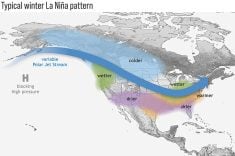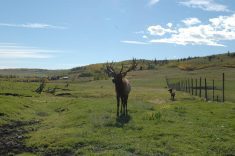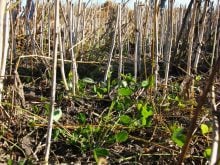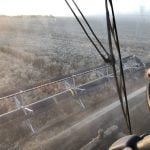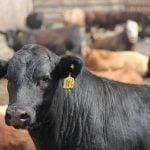FORT ST. JOHN, B.C. – Not many farmers get a second chance to start
farming.
Even though Bill and Heather Bickford are established farmers, buying a
9,000-acre ranch in the rugged Buick Creek area is like starting over
for the northern British Columbia family.
“I’m excited about it,” said Bill, who moved from Victoria to Fort St.
John as a cabinet maker in 1965 before buying his first farm.
“I think it will provide some real nice family opportunities. When the
Read Also

Trump’s tariffs take their toll on U.S. producers
U.S. farmers say Trump’s tariffs have been devastating for growers in that country.
cattle are there it’s going to be fun,” Heather said as she sat at the
kitchen table with a view of the Fort St. John Creek that runs past the
four homes in the yard. Almost the entire east wall of her house has
windows that look over the rolling field down to the coulee.
The Bickford family began looking for ways to expand as more family
members joined the operation. On the 5,000-acre grain and 300-head
purebred Angus farm north of Fort St. John are Bill and Heather, their
son and daughter-in-law Gary and Rachelle Bickford, and daughter and
son-in-law Sharlene and Rick Kantz, plus a full-time hired hand.
Although they also had the opportunity to buy a nearby 850-acre
developed farm, the family didn’t feel it offered the same development
potential as the 9,000-acre Buick Creek ranch, which was 100 kilometres
north, but the same price.
“This ranch will give us a new direction,” said Heather, who has been
involved for many years in the International Agriculture Exchange
Association program.
While the new ranch offers plenty of possibilities, many buyers were
turned off by its isolated location, poor condition, and lack of
telephone and power utilities.
“It’s not a prosperous looking area,” Bill said.
The Buick Creek ranch began in 1966, but a series of owners who cleared
land and logged timber left the ranch with a patchwork of trees,
stumps, grass and broken fences. Many of the logged areas have since
started to regrow, leaving stumps and narrow brush.
“It’s cattle country, that’s all,” said Kantz, who is responsible for
the family’s cattle.
“The logged-off stuff is going to be a challenge.”
He estimated it will take several years to improve the ranch.
The main cattle herd will be moved permanently to the Buick Creek
ranch this spring. The herd will eventually be expanded to 500 head,
and calving will be pushed back to April or May.
“They’re going to be the most disappointed animals you’ve ever seen,”
said Bill of the animal’s reaction to the sparse conditions.
The cows now start to calve in February and newborn calves are tagged
and checked in a pole shed.
“On a real nasty day those things are packed with calves,” he said.
Oilfield tanks have also been cut in half to serve as inexpensive calf
shelters.
The oilfield is a major source of income in B.C.’s Peace River region,
and remnants of its activity are scattered across the farmyard.
Sucker rod and drill stem from oil and gas drilling rigs are piled in
the calving yard, while fences and feed troughs are made from used
oilfield pipe. Large oil tanks double as grain storage.
“The price was right,” said Bill about the inventory. He keeps his eye
open for opportunities. The quarter section that acts as the main
cattle area was purchased in a bank sale.
“We’ve got to keep pushing for the cheapest thing to do the best job.”
The push to find better and cheaper ways means working together. Every
Monday morning the family meets to discuss what needs to be done that
week and to update each other on the markets.
When the local Agricore United elevator offered $4 a bushel for feed
wheat, they made the decision together to accept. With no feedlots in
the area, there are few opportunities to sell grain. Most wheat and
barley is sold through the Canadian Wheat Board. By expanding their
cattle herd and finishing the calves, they hope to feed more grain
through their cattle and expand their options for grain sales.
This week Gary, in charge of grain farming, was in Winnipeg at a
Canadian Wheat Board seminar to learn more about the prairie grain
industry. Gary and Rick have just started a marketing club where young
farmers can meet and share ideas about grain and cattle.
“It’s really good to see the young people take on the responsibility of
farming. It’s not easy,” Heather said.
Even though many farmers would consider Fort St. John too remote to
farm, Bill hasn’t regretted the move north from Victoria. Even in a bad
year there is always sufficient moisture to prevent a total crop
failure and good grain land can be rented for $10 to $20 per acre.
“This country has been really good to us,” he said.



